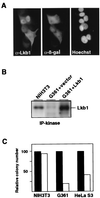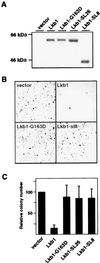Growth suppression by Lkb1 is mediated by a G(1) cell cycle arrest
- PMID: 10430928
- PMCID: PMC17765
- DOI: 10.1073/pnas.96.16.9248
Growth suppression by Lkb1 is mediated by a G(1) cell cycle arrest
Abstract
Germ-line mutations of LKB1 (STK11) lead to Peutz-Jeghers syndrome characterized by gastrointestinal polyps and cancer of different organ systems. The mutations lead to loss or severe impairment of Lkb1 serine/threonine kinase activity. Therefore LKB1 has been implicated as a tumor suppressor gene, but only a few mutations in the coding exons of LKB1 have been detected in sporadic tumors. Here, we have identified tumor cell lines with severely reduced mRNA levels and impaired Lkb1 kinase activity. Reintroducing Lkb1 into these cells suppressed cell growth. The Lkb1-mediated growth inhibition was caused by a G(1) cell cycle block and was not detected with several naturally occurring Lkb1 mutants. These results indicate that LKB1 has functional and specific growth-suppressing activity.
Figures




References
-
- Hemminki A, Tomlinson I, Markie D, Jarvinen H, Sistonen P, Bjorkqvist A M, Knuutila S, Salovaara R, Bodmer W, Shibata D, et al. Nat Genet. 1997;15:87–90. - PubMed
-
- Hemminki A, Markie D, Tomlinson I, Avizienyte E, Roth S, Loukola A, Bignell G, Warren W, Aminoff M, Hoglund P, et al. Nature (London) 1998;391:184–187. - PubMed
-
- Jenne D E, Reimann H, Nezu J, Friedel W, Loff S, Jeschke R, Muller O, Back W, Zimmer M. Nat Genet. 1998;18:38–43. - PubMed
-
- Gruber S B, Entius M M, Petersen G M, Laken S J, Longo P A, Boyer R, Levin A M, Mujumdar U J, Trent J M, Kinzler K W, et al. Cancer Res. 1998;58:5267–5270. - PubMed
Publication types
MeSH terms
Substances
LinkOut - more resources
Full Text Sources

